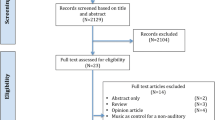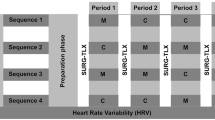Abstract
Purpose
Music is often played in operating theaters. In the literature, the effects of music on surgeons are controversial. We aimed to investigate the effect of different music genres and amplitudes on laparoscopic performance.
Methods
Novice surgeons underwent a proficiency-based laparoscopic training curriculum. Participants were required to perform these tasks under three conditions: no music, with music in medium volume (45–50 dB) and in high volume (65–70 dB). Soft rock by the Beatles and hard rock by AC/DC were played. Task performance was evaluated by analyzing speed and accuracy.
Results
With soft rock in medium volume, participants were faster in peg transfer (60.3 vs. 56.7 s, P = 0.012) and more accurate in suture with intracorporeal knot (79.2 vs. 54.0, P = 0.011) compared to without music. The total score was improved (383.4 vs. 337.9, P = 0.0076) by enhancing accuracy (79.5 vs. 54.0, P = 0.011). This positive effect was lost if the soft rock was played in high volume. With hard rock in medium volume, participants were faster performing precision cutting (139.4 vs. 235.8, P = 0.0009) compared to without music. Both balloon preparation and precision cutting were performed more rapidly (227.3 vs. 181.4, P = 0.003, 139.4 vs. 114.0, P < 0.0001) and the accuracy was maintained. Hard rock in high volume also resulted in increased speed (366.7 vs. 295.5, P < 0.0001) compared to without music. Thereby, the total scores of participants were enhanced (516.5 vs. 437.1, P = 0.002).
Conclusion
Our data reveal that the effect of music on laparoscopic performance might depend on the combination of music genre and amplitude. A generally well-accepted music genre in the right volume could improve the performance of novice surgeons during laparoscopic surgeries.
Trial Registration
DRKS00026759, register date: 18.10.2021 (retrospectively registered).

Similar content being viewed by others
References
Nietzsche F (1889) The twilight of the idols
Geist K, Geist EA (2012) Bridging music neuroscience evidence to music therapy best practice in the early childhood classroom: implications for using rhythm to increase attention and learning. Music Ther Perspect 30:141–144. https://doi.org/10.1093/mtp/30.2.141
Rauscher FH, Shaw GL, Ky KN (1993) Music and spatial task performance. Nature 365:611. https://doi.org/10.1038/365611a0
Pietschnig J, Voracek M, Formann AK (2010) Mozart effect–Shmozart effect: a meta-analysis. Intelligence 38:314–323. https://doi.org/10.1016/j.intell.2010.03.001
Ullmann Y, Fodor L, Schwarzberg I et al (2008) The sounds of music in the operating room. Injury 39:592–597. https://doi.org/10.1016/j.injury.2006.06.021
Makama JG, Ameh EA, Eguma SA (2010) Music in the operating theatre: opinions of staff and patients of a Nigerian teaching hospital. Afr Health Sci 10:386–389
Fagure (2017) Spotify and Figure 1 team up to hear what surgeons are playing in the OR. In: Fig. 1. https://www.figure1.com/post/spotify-and-figure-1-team-up-to-hear-what-surgeons-are-playing-in-the-or. Accessed 5 Jan 2021
Bosanquet DC, Glasbey JC, Chavez R (2014) Making music in the operating theatre. BMJ 349:g7436. https://doi.org/10.1136/bmj.g7436
Moris DN, Linos D (2013) Music meets surgery: two sides to the art of “healing.” Surg Endosc 27:719–723. https://doi.org/10.1007/s00464-012-2525-8
Allen K, Blascovich J (1994) Effects of music on cardiovascular reactivity among surgeons. JAMA 272:882–884
Way TJ, Long A, Weihing J et al (2013) Effect of noise on auditory processing in the operating room. J Am Coll Surg 216:933–938. https://doi.org/10.1016/j.jamcollsurg.2012.12.048
C Yang J Heinze J Helmert et al 2017 Impaired laparoscopic performance of novice surgeons due to phone call distraction: a single-centre, prospective study SurgEndosc https://doi.org/10.1007/s00464-017-5609-7
Bechtolsheim F, Oehme F, Weitz J et al (2020) The hunger games: laparoscopic performance in novice surgeons is not altered by food deprivation but influenced by the degree of appetite - a randomized controlled trial. J Surg Educ 77:1236–1243. https://doi.org/10.1016/j.jsurg.2020.03.029
Cowan JB, Seeley MA, Irwin TA, Caird MS (2016) Computer-simulated arthroscopic knee surgery: effects of distraction on resident performance. Orthopedics 39:e240-245. https://doi.org/10.3928/01477447-20160119-05
Moorthy K, Munz Y, Undre S, Darzi A (2004) Objective evaluation of the effect of noise on the performance of a complex laparoscopic task. Surgery 136:25–30; discussion 31. https://doi.org/10.1016/j.surg.2003.12.011
Miskovic D, Rosenthal R, Zingg U et al (2008) Randomized controlled trial investigating the effect of music on the virtual reality laparoscopic learning performance of novice surgeons. Surg Endosc 22:2416–2420. https://doi.org/10.1007/s00464-008-0040-8
VX Fu P Oomens VEE Kleinrensink et al 2020 The effect of preferred music on mental workload and laparoscopic surgical performance in a simulated setting (OPTIMISE): a randomized controlled crossover study. Surg Endosc. https://doi.org/10.1007/s00464-020-07987-6
Derossis AM, Bothwell J, Sigman HH, Fried GM (1998) The effect of practice on performance in a laparoscopic simulator. Surg Endosc 12:1117–1120
Peters JH, Fried GM, Swanstrom LL et al (2004) Development and validation of a comprehensive program of education and assessment of the basic fundamentals of laparoscopic surgery. Surgery 135:21–27. https://doi.org/10.1016/S0039
Vassiliou MC, Dunkin BJ, Marks JM, Fried GM (2010) FLS and FES: comprehensive models of training and assessment. Surg Clin North Am 90:535–558. https://doi.org/10.1016/j.suc.2010.02.012
SECO S für W Lärm, Akustik, Vibrationen. https://www.seco.admin.ch/seco/de/home/Arbeit/Arbeitsbedingungen/gesundheitsschutz-am-arbeitsplatz/Arbeitsraeume-und-Umgebungsfaktoren/Laerm-Akustik-Vibrationen.html. Accessed 6 Jan 2021
Engelmann CR, Neis JP, Kirschbaum C et al (2014) A noise-reduction program in a pediatric operation theatre is associated with surgeon’s benefits and a reduced rate of complications: a prospective controlled clinical trial. Ann Surg 259:1025–1033. https://doi.org/10.1097/SLA.0000000000000253
P Oomens VX Fu GJ Kleinrensink J Jeekel 2019 The effect of music on simulated surgical performance: a systematic review SurgEndosc https://doi.org/10.1007/s00464-019-06868-x
El Boghdady M, Ewalds-Kvist BM (2020) The influence of music on the surgical task performance: a systematic review. Int J Surg Lond Engl 73:101–112. https://doi.org/10.1016/j.ijsu.2019.11.012
Nees LK, Grozinger P, Orthmann N et al (2021) Evaluating the influence of music at different sound pressure levels on medical students’ performance of standardized laparoscopic box training exercises. BMC Med Educ 21:209. https://doi.org/10.1186/s12909-021-02627-6
Nees LK, Grozinger P, Orthmann N et al (2021) The influence of different genres of music on the performance of medical students on standardized laparoscopic exercises. J Surg Educ 78:1709–1716. https://doi.org/10.1016/j.jsurg.2021.03.008
Siu K-C, Suh IH, Mukherjee M et al (2010) The effect of music on robot-assisted laparoscopic surgical performance. Surg Innov 17:306–311. https://doi.org/10.1177/1553350610381087
Conrad C, Konuk Y, Werner P et al (2010) The effect of defined auditory conditions versus mental loading on the laparoscopic motor skill performance of experts. Surg Endosc 24:1347–1352. https://doi.org/10.1007/s00464-009-0772-0
Kam PCA, Kam AC, Thompson JF (1994) Noise pollution in the anaesthetic and intensive care environment. Anaesthesia 49:982–986. https://doi.org/10.1111/j.1365-2044.1994.tb04319.x
Staum MJ, Brotons M (2000) The effect of music amplitude on the relaxation response. J Music Ther 37:22–39. https://doi.org/10.1093/jmt/37.1.22
Dankelman J, Chmarra MK, Verdaasdonk EGG et al (2005) Fundamental aspects of learning minimally invasive surgical skills. Minim Invasive Ther Allied Technol 14:247–256. https://doi.org/10.1080/13645700500272413
Rasmussen J (1983) Skills, rules, and knowledge; signals, signs, and symbols, and other distinctions in human performance models. IEEE Trans Syst Man Cybern SMC-13:257–266. https://doi.org/10.1109/TSMC.1983.6313160
Acknowledgements
We thank Prof. Christel Weiss, Department of Medical Statistics and Biomathematics, Medical Faculty Mannheim, Heidelberg University, Germany, for statistical analysis review.
Author information
Authors and Affiliations
Contributions
Study conception and design: CY, FM, CR, JW, STM. Acquisition of data: CY, FM. Analysis and interpretation of data: CY, FM, STM. Drafting of manuscript: CY, FM, STM. Critical revision of manuscript: CR, JW.
Corresponding author
Ethics declarations
Conflict of interest
The authors declare no competing interests.
Additional information
Publisher's note
Springer Nature remains neutral with regard to jurisdictional claims in published maps and institutional affiliations.
Rights and permissions
About this article
Cite this article
Yang, C., Möttig, F., Weitz, J. et al. Effect of Genre and amplitude of music during laparoscopic surgery. Langenbecks Arch Surg 407, 2115–2121 (2022). https://doi.org/10.1007/s00423-022-02490-z
Received:
Accepted:
Published:
Issue Date:
DOI: https://doi.org/10.1007/s00423-022-02490-z




